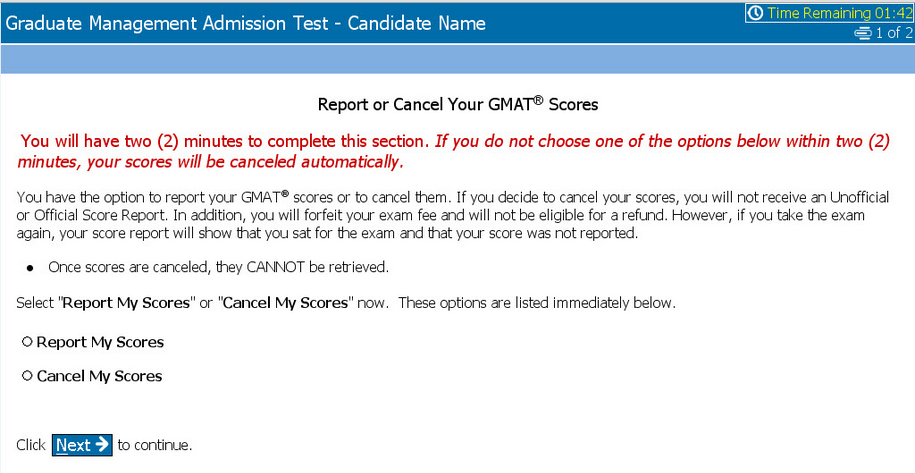
The change can also be viewed as a way in which GMAC continues to test the decision-making skills of the applicants for top management studies even after the end of the test itself, because they have to leverage risk and financial implications. Those who focus on the anxiety factor of the GMAT feel the new policy gives more freedom and comfort.
Two strategies before 27 June, 2014
Before the change, test takers could opt to automatically report their scores to graduate programmes, but they had to decide whether to do so before they actually knew their preliminary score. The process required that test takers list (if they chose to) up to five score recipients at the start of the test. So, test takers had to take the risk of reporting scores without knowing how good they actually would be – simply trusting their own assessment of how they would perform in the test. This meant that there were two possible score reporting strategies.
The first one
was the above option, where test takers listed up to five programmes after reporting to the test centre, but before they actually started the test. Sending an official score report to these programmes was covered by the test fee of 250 USD (plus VAT) and scores were released as soon as the official score was available – typically up to 20 days after the test date. If test takers wanted to send scores to more than five schools, they paid an additional fee of about 20 USD per additional score report.
The second option
was that test takers did not list score recipients at the start of the test. In this case, the official score was reported only to the test taker. Then, he/she could decide whether to send the score to schools, ordering additional score reports for about 20 USD each.
In both cases, GMAC reported to the designated programmes all scores of the test taker for the past five years. This put the test takers under additional pressure to improve their scores on each test in order to show progress, although business schools actually have different policies on which scores they take into consideration. Some schools, including Harvard Business School, consider only the best score of the applicant when they review the application for admission. Other schools take the average of all GMAT tests taken, yet others just consider the latest score.
New challenges as of 27 June, 2014
Now, test takers can first see their preliminary score, before deciding whether to report it. However, their decision will have various implications, including financial ones.
At the end of the test and before leaving the test centre, test takers see their preliminary score on the Quantitative, Verbal and Integrated Reasoning sections, as well at the Total score. The Analytical Writing Assessment section is not scored immediately at the end of the test, so it does not show on the preliminary score report.
Now comes the new challenge.
Test takers have two minutes to decide whether to report or cancel their score. If they cancel it, it will not be reported to any of the institutions which they listed at the start of the test, nor will an unofficial score report be issued to the test taker.
See a screenshot of the moment when you have to take the decision.

If a test taker retakes the test later on and reports his/her second score, the cancellation of this previous score will be listed in the score report. So, schools will know that the test taker took the test but was unhappy with the score and decided not to report it. However, schools will not know the score.
The new score reporting policy provides an additional option. Test takers can reinstate their cancelled score within 60 days of the test date, but they have to pay a fee of 100 USD (plus VAT). Since they cancelled the score they will not have the authentication number of their test, which is needed to report scores, but this will be provided by phone when they order the reinstatement of the scores. When the scores are reinstated, they will automatically be reported to the programmes which the test taker listed at the start of the test.
How is the new change perceived?
One month after it was introduced, the score reporting change is evoking contradictory reactions.
Some experts see a marketing argument behind this step, in response to the promotion which the Educational Testing Service (ETS) has been doing for the GRE – the alternative to the GMAT accepted by a growing number of business schools.
“The Educational Testing Service, which administers the GRE, has long promoted the fact that its test takers can decide which scores to send to schools even if they take the GRE test more than once, giving that alternative exam a marketing advantage”,
says John A. Byrne, Poets and Quants.
Some test takers feel the moment was not right to introduce the change as now the new situation may affect the chances of admission of some applicants to top US MBA programmes. Some applicants are sharing in forums that they feel it “is unfair” to make the change “near the peak of the GMAT taking cycle-- should have been on 1st January, well after all Round 1 and when most Round 2 applicants have taken the test”.
Others are concerned about how business schools will interpret a cancelled score on the score report saying “This might make a cancelled score appear more ambiguous to admission committees to interpret. People usually cancel because they do poorly. But now, you might see good candidates cancel because they didn't get a jump from 700 to 740 or 680 to 720.”
“Just knowing you have that option will help you feel more confident on test day”, according to GRE representatives quoted by John A.Byrne. Test takers who have already taken a test under both the old and the new policies tend to agree. “At the back of my mind, the ability to cancel my score was a huge relief.”
Obviously, the new GMAT score reporting policy calls for new strategies for school selection, planning when to take the test and how many times to take it, as well as securing the budget. The next articles will provide you with seven strategies and scenarios to consider, under the new GMAT score reporting policy.



Comments